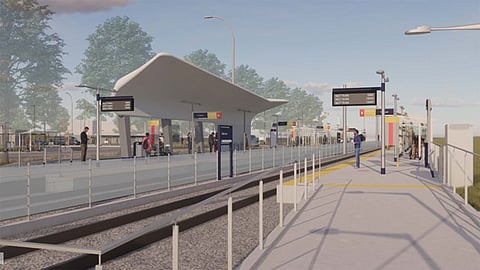

The City of Calgary was taken by surprise on Friday when it received notice from the Alberta Government it had a new report detailing a new alignment for the Green Line.
In July, the province contracted consulting firm AECOM, “to identify and assess an alternative at-grade and/or elevated route through the downtown core that will achieve a functional, cost-effective Green Line,” the government said in a statement, adding a report from AECOM proposed “a new Green Line alignment from 7 Ave. to Shepard that more closely aligns with the initial provincially and federally approved business case from June 2021.”
On Monday, at a press conference attended by Mayor Jyoti Gondek and Cllrs. Andre Chabot (Ward 10) and Peter Demong (Ward 14), Gondek said, “We were assured early December would be the timing of a completed report from AECOM. The AECOM report was submitted to the provincial government on December 3rd."
Gondek said the city received the report verbally at 7 a.m. Friday, with a written report and financial considerations arriving close to 10 p.m. that evening.
The report was marked confidential.
“This puts the city in a difficult position where we would be as transparent as possible with Calgarians about what was being proposed in terms of a new alignment as well as the financial summary, but we’re not sure what we can share publicly and we continue to engage with the province to find out what we can make of it,” said Gondek.
In its statement, the Alberta government said the new plan was designed to increase ridership, connecting to the Red and Blue lines, the new event centre and go further into southeast Calgary than the original plan.
“This new Green Line route saves more than a billion dollars in tunnelling costs,” said Minister of Transportation and Economic Corridors Devin Dreeshen.
“This alignment adds five more stops, will be 76% longer and will serve 60% more Calgarians, all within the same budget. The ball is now in Calgary city council's court to approve this alignment and to finally start construction on the Green Line in the new year."
"The alignment is only one part of the overall puzzle. We're still waiting for the provincial government to say they will take on the financial risk in the new project,” said Gondek on Monday. “We do not have an understanding of the impact."
"In short there’s more information that’s needed and there are many more questions that need to be posed and further discussions and negotiations need to take place before any decisions will be made (by city council).”
In a statement issued Monday afternoon, Dreeshen said, "The new proposed alignment reflects the original goals of the Green Line by significantly increasing ridership and ensuring more Calgarians can benefit from this critical transit project."
"It's important to note that this remains a City of Calgary project. I encourage the city to thoroughly review the report and bring forward any questions or feedback they may have as we continue to work together delivering a cost-effective and functional transit solution for Calgarians."
"The AECOM report will not be made public as its contents are integral to the upcoming bidding process for the proposed route. Releasing the report at this stage could compromise the fairness and competitiveness of the process, which is essential to ensuring the best outcome for taxpayers."
On Tuesday, council, as part of its regular meeting, will go behind closed doors to discuss the new alignment.
“We will have a discussion about what we have received to date and we will determine the questions that need to be answered before decisions can be made,” said Gondek.
“Just as we were patient for three months with the provincial government while they took their time to come back to the table and they took over the new alignment for the replacement of the Green Line we need them to give us some time to understand the costs, the risks and the proposed alignment.”
“There are a lot of financial implications with the previous alignment including costs, financing and additional funding,” said Chabot.
“At this point it would be irresponsible for us to make a decision without the opportunity to review and assess what has been presented to us and having the opportunity to go back to the provincial government and say ‘there are a lot things that need to happen, including engaging the business sector, as well as the public to assess their opinion. We want to be transparent.”
